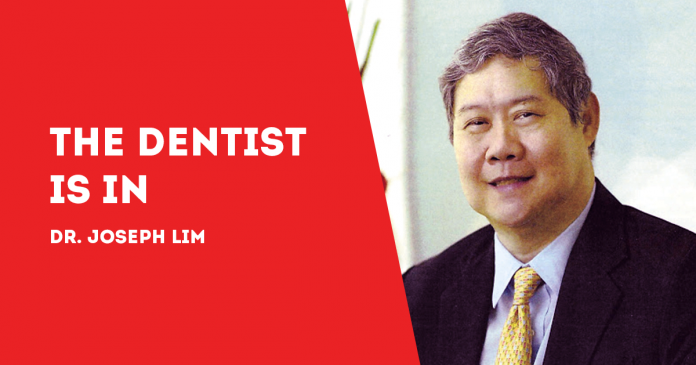
(By Dr. Joseph D. Lim and Dr. Kenneth Lester Lim, BS-MMG, DDM, MSc-OI)
WE KNOW the minimum health protocol to prevent COVID transmission, as prescribed by the Department of Health.
These are social distancing, washing or sanitizing hands, getting full vaccinations, avoiding crowds – and ventilating homes.
The same applies in dentistry: ventilation is a major and easy-to-implement way to prevent COVID infections in a dental setting.
The reason is that a lot of procedures inside the dental clinic produce spatters, droplets, and aerosols. The COVID-bearing aerosols or droplets that are suspended in the air may potentially spread the virus.
The proper airing or ventilating of the clinic (and the inside of your homes) will significantly lessen the virus load in the air.
There is science to this. New research published in the Journal of Dentistry shows that when the ventilation rate is low inside an enclosed place, respiratory aerosol particles can remain in the indoor air for a long time.
Researchers at the Eastman Institute for Oral Health (EIOH) research which made the study concludes that it is critical to facilitate the removal of respiratory aerosol from the indoor environment to minimize potential exposures of airborne viruses such as COVID to patients and dental care providers.
Researchers at the EIOH, a part of the University of Rochester Medical Center, have developed a tool that helps dentists and their staff assess the ventilation rate for any room.
The calculator measures air changes per hour. Along with a simple process and other tools, the calculator is easy to use.
“Knowing what the ventilation rate is for individual dental treatment rooms will help providers understand what steps they can take, if necessary, to improve ventilation,” said Dr. Yanfang Ren, a dentist and EIOH professor whose research about dental treatment provision, aerosol behavior and ventilation, has been widely cited throughout the pandemic.
“We found that carbon dioxide levels in dental treatment rooms are directly associated with ventilation rate and the number of people in the room,” Dr. Ren said.
The study that he led is the basis for developing the ventilation calculator.
The calculator is used with a carbon dioxide monitor, household baking soda and vinegar to determine the air change rate inside a room.
The calculator, using the recommendation of the US Centers for Disease Control and Prevention, improves the ventilation rate to 15 air changes per hour in dental treatment rooms.
“Many factors play a role in the ventilation rate for any given room, including the HVAC (Heating, Ventilation and Air Conditioning) system, size and design of the rooms, and structure and age of the building,” said Dr. Ren. “Improving a room’s ventilation could be as easy as adding a portable air cleaner.”
The Clean Air Delivery Rate is first determined so that the desired air change rate is achieved.
“The higher the Clean Air Delivery Rate, the faster the portable air cleaner cleans the air,” Dr. Ren explained. “When selecting a portable air cleaner for dental treatment rooms, use the rating for tobacco smoke, which represents the sizes of small dental aerosols that are the most difficult to clean.”
Proper ventilation and air filtration are effective when used along with strict health protocols during the COVID pandemic or whenever there is an outbreak of infectious respiratory disease.
For example, patients must undergo pre-appointment screening for signs and symptoms. The proper physical distancing must be observed at all times. Patients must undergo mouth rinsing before dental procedures.
Personal protective equipment, N95 masks, protective goggles or face-shields are all essential for the dentist and the dental staff. Regular disinfection and cleaning must also be conducted in the premises to prevent the potential spread of COVID-19.
More information is available at the EIOH Covid Safety & Resources website about the Clean Air Delivery Rate and how to calculate the Air Change Rate for a portable air cleaner. The website includes a video demonstration and an email address for questions.
***
Dr. Joseph D. Lim is the former Associate Dean of the College of Dentistry, University of the East; former Dean, College of Dentistry, National University; Past President and Honorary Fellow of the Asian Oral Implant Academy; Honorary Fellow of the Japan College of Oral Implantologists; and Honorary Life Member of the Thai Association of Dental Implantology. For questions on dental health, e-mail jdlim2008@gmail.com or text 0917-8591515.
***
Dr. Kenneth Lester Lim, BS-MMG, DDM, MSc-OI, graduated Doctor of Dental Medicine, University of the Philippines College of Dentistry, Manila, 2011; Bachelor of Science in Marketing Management, De la Salle University, Manila, 2002; and Master of Science (MSc.) in Oral Implantology, Goethe University, Frankfurt, Germany, 2019. He is an Associate professor; Fellow, International Congress of Oral Implantologists; Member, American Academy of Implant Dentistry and Philippine College of Oral Implantologists. For questions on dental health, e-mail limdentalcenter@gmail.com/PN



